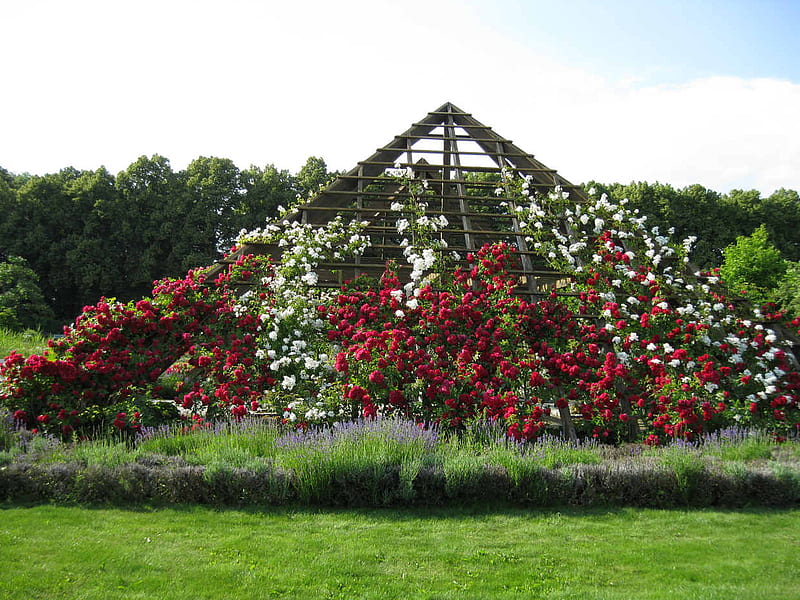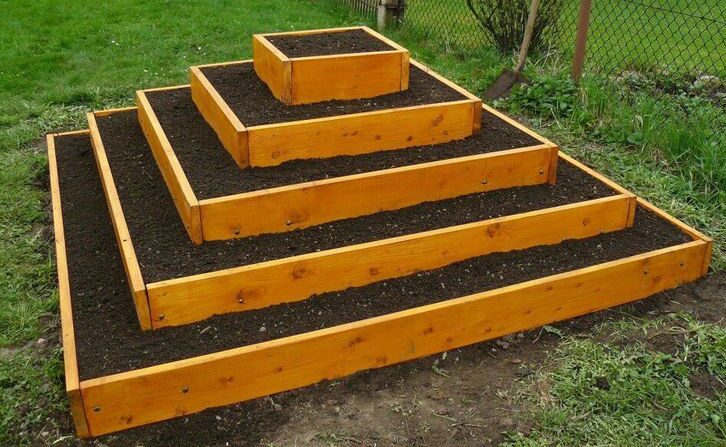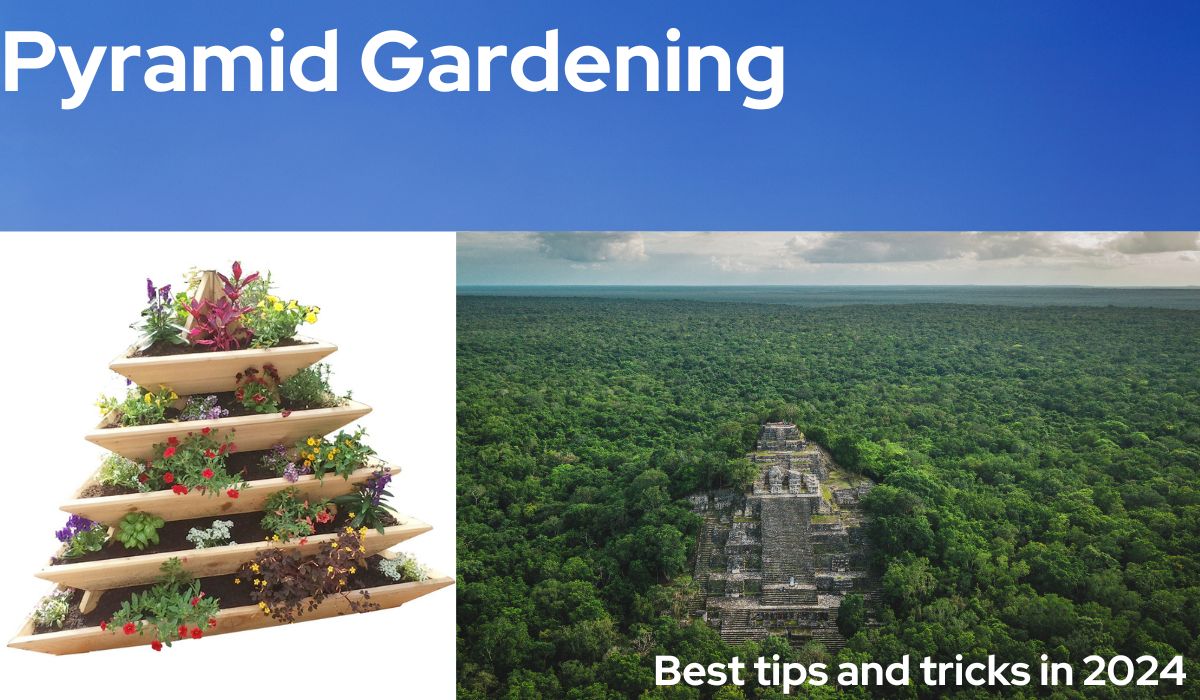Introduction – Pyramid Gardening
In a generation where sustainable living and self-sufficiency are increasingly famous, gardening sticks out as a cornerstone of this movement. Yet, conventional gardening methods frequently call for considerable expanses of land, presenting a task for urban dwellers with restricted outdoor areas.
Enter pyramid gardening—an innovative approach that defies spatial constraints by optimizing vertical area.
Pyramid gardening or vertical gardening, additionally known as vertical gardening or tiered gardening, ingeniously arranges plant life in a pyramid-shaped structure, providing a compact but green means to cultivate a numerous array of plants.
This method not best addresses the spatial obstacles confronted by using city gardeners but additionally capitalizes on sunlight exposure and airflow to decorate yields.
As a reachable and visually attractive method, pyramid gardening has captured the creativity of gardening lovers globally, supplying a pathway to sustainable, homegrown produce irrespective of space constraints.
This article explores the ideas, advantages, and realistic aspects of pyramid gardening or vertical gardening, empowering people to embark on their journey towards plentiful harvests within restrained spaces.
What is Pyramid Gardening?

Pyramid gardening, also referred to as vertical gardening or tiered gardening, includes arranging plants in a pyramid-formed structure to make the most efficient use of the area. The concept is simple yet powerful: By stacking planting beds vertically, gardeners can grow a significant quantity of produce in a small vicinity.
This approach is especially properly perfect for developing veggies, herbs, and plants, and it can be tailored to accommodate numerous varieties of flowers and growing conditions.
Benefits of Pyramid Gardening
Space Efficiency
One of the primary advantages of pyramid gardening is its capability to maximize area. By making use of vertical space, gardeners can grow greater plants in a smaller footprint, making it best for city and small-space gardening.
Increased Yield
The vertical association of plant life in pyramid gardens allows for better sunlight publicity and air movement, which can cause higher yields in comparison to traditional gardening techniques. Additionally, the tiered shape allows gardeners to plant loads of vegetation, optimizing the use of available space and growing basic productivity.
Accessibility
Pyramid gardens are designed to be easily handy, with planting beds organized at numerous heights to deal with gardeners of every age and capability. This accessibility makes it an ideal option for people with restrained mobility or those who decide no longer to bend or kneel at the same time as gardening.
Aesthetic Appeal
In addition to their realistic advantages, pyramid gardens can decorate the visual appeal of outside areas. The tiered structure creates a dynamic and desirable display, adding beauty and hobby to gardens, patios, and balconies.
Getting Started with Pyramid Gardening

Setting up a pyramid lawn is notably honest and calls for minimum substances and equipment. Here are a few steps that will help you get commenced:
Choose a Location
Select a suitable region in your pyramid lawn, thinking of elements that include sunlight exposure, drainage, and proximity to water resources. Ideally, the area ought to acquire at least six hours of daylight in step with day.
Build the Frame
Construct a robust body in your pyramid lawn the usage of substances including wooden, metal, or recycled materials. The frame needs to be pyramid-shaped, with every tier slightly smaller than the one below it, to allow for correct drainage and airflow.
Prepare the Soil
Fill every tier of the pyramid with an outstanding potting mix or lawn soil enriched with compost and organic be counted. Ensure that the soil is properly drained and unfastened from particles or contaminants.
Planting
Choose plenty of flowers ideal for your weather and developing conditions, considering elements consisting of daylight requirements, spacing, and compatibility. Plant taller plants, including tomatoes, peppers, and beans, on the decreased levels, and shorter crops together with lettuce, herbs, and plants on the higher stages.
Watering and Maintenance
Regular watering is important for the success of your pyramid garden, particularly during hot weather or dry intervals. Monitor soil moisture stages and water as needed to maintain plant life healthy and hydrated. Additionally, be sure to fertilize regularly and maintain an eye out for pests and illnesses that can affect your flora.
Harvesting
As your flowers develop and mature, harvest the result, veggies, and herbs as they grow to be geared up for choosing. Regular harvesting encourages persevered increases and ensures a regular delivery of clean produce throughout the developing season.
Tips for Success for Pyramid Gardening

Start Small
If you’re new to pyramid gardening or vertical gardening, start with a small-scale venture to advantage enjoy and self-assurance earlier than increasing to larger gardens.
Rotate Crops
To prevent soil depletion and limit pest and disorder troubles, rotate your vegetation yearly, planting distinct kinds of vegetation in each tier.
Provide Support
Some plants may additionally require extra support as they grow, including trellises or stakes for vining vegetation like cucumbers and peas.
Experiment and Have Fun
Don’t be afraid to test with different plant varieties, layouts, and techniques to locate what works fine on your lawn. Remember that gardening is a getting-to-know technique, and there may be constant room for creativity and exploration.
Conclusion – Pyramid Gardening
In conclusion, pyramid gardening or vertical gardening emerges as a beacon of wish for city gardeners and sustainability fanatics alike. Through its innovative use of vertical space, this approach transcends the limitations of conventional gardening, offering a feasible answer for maximizing yields in compact environments.
By harnessing the strength of daylight, airflow, and efficient area usage, pyramid gardens empower people to cultivate a rich variety of plants, from clean veggies to fragrant herbs, proper at their doorstep.
Beyond its realistic benefits, pyramid gardening embodies a deeper ethos of self-sufficiency, environmental stewardship, and connection to nature.
As we navigate a more and more unsure destiny, this sustainable gardening approach gives a tangible way for individuals to lessen their ecological footprint, sell meals security, and foster a sense of resilience within their communities.
As we mirror the potential of pyramid gardening to convert our city landscapes and nourish our bodies and souls, let us include its concepts with enthusiasm and creativity.
Together, let us domesticate a greener, extra sustainable future—one pyramid garden at a time.
#pyramidgardening #verticalgardening
What exactly is pyramid gardening?
Pyramid gardening is a technique that involves arranging plant life in a pyramid-fashioned shape to maximize area and yield in a compact area. It's also referred to as vertical gardening or tiered gardening.
What are the advantages of pyramid gardening?
Pyramid gardening offers numerous benefits, inclusive of maximizing area performance, growing yields, enhancing accessibility, and improving the visual enchantment of outdoor areas. It's additionally an excellent way to develop a whole lot of plants in a restrained space.
What types of vegetation are appropriate for pyramid gardening?
Pyramid gardening can accommodate a wide range of flowers, inclusive of greens, herbs, flowers, and even small results. Choose plants that are applicable to your climate and developing conditions, and remember the quantity of sunlight each plant requires.
How do I construct a pyramid garden?
To construct a pyramid lawn, you'll need to assemble a strong body in the form of a pyramid, with each tier barely smaller than the one below it. Fill every tier with a brilliant potting blend or garden soil, and then plant your chosen vegetation according to their spacing and sunlight requirements.
Do pyramid gardens require quite a little maintenance?
Like any lawn, pyramid gardens require everyday preservation, which includes watering, fertilizing, and pest management. However, due to the fact plants are arranged vertically, they may require less weeding and bending in comparison to standard gardens.
Can I develop greens year-round in a pyramid garden?
The capacity to grow vegetables year-round in a pyramid lawn relies upon your climate and the varieties of vegetation you pick out to grow. In colder climates, you could need to apply season extenders, which include row covers or bloodless frames to defend flowers from frost.
Are there any barriers to pyramid gardening?
While pyramid gardening is a flexible and green method, it may now not be appropriate for all conditions. For example, extraordinarily big or heavy plants won't be desirable to vertical development, and some gardeners may additionally decide upon the aesthetics of traditional gardens.
Can I use recycled materials to construct a pyramid lawn?
Yes, you may use recycled materials, including antique pallets, crates, or bins, to construct a pyramid garden. Just make certain the materials are sturdy enough to assist the burden of the soil and plant life and that they're unfastened from any dangerous chemicals or contaminants.
How a good deal of sunlight does a pyramid garden want?
Most flora require at least six hours of sunlight in keeping with the day to thrive, so it is vital to pick out an area in your pyramid garden that gets ok daylight. If you have confined sunlight on your yard or balcony, take into account growing plants that tolerate partial color.
Can I personalize the dimensions and shape of my pyramid lawn?
Absolutely! Pyramid gardens may be custom-designed to fit your space and choices. You can regulate the dimensions and wide variety of ranges to house extraordinary flowers and developing situations, and you may even add functions like trellises or irrigation structures to enhance functionality.
Digital Marketing Services, SEO and E-Commerce Solutions in Delhi, India
Author – Farhanul Haque
The article “Pyramid Gardening: Maximizing Space and Yield in Your Garden” is written by the Founder of Digitamizer who has been working in the e-Commerce Sector Since 2006 and is also a certified Digital Marketing Professional from IIT, Delhi, India.


Thanks for sharing. I read many of your blog posts, cool, your blog is very good.
Thanks for sharing. I read many of your blog posts, cool, your blog is very good.